
Retailers who successfully leverage computer vision with diagnostic, proactive, and predictive analytics are gaining the much-needed competitive edge.
Not only are you able to get a competitive edge, but you can also see how shopping habits change in real-time
This week we dive deep into the benefits of computer vision and retail and uncover how consumers are spending their money.
THIS WEEK’S HIGHLIGHTS
- Computer vision meets retail: How stores are utilizing the overload of data.
- Impulse buys: Everything you need to know about the e-commerce shift.
- Report: Trends in retail you must know to attract on-the-go consumers.
FOOT TRAFFIC INDEX
Here’s a look at last week’s foot traffic compared to the same time last year.

FOOT TRAFFIC TRENDS
Industry insights so you can convert your foot traffic into more sales.
Computer vision meets retail
Retailers who successfully leverage computer vision with diagnostic, proactive, and predictive analytics are gaining the much-needed competitive edge.
Computer vision provides video and audio for additional context, complementing other types of data. No matter if you are at your store for 9 hours a day, or an hour a week, it is impossible to see everything the way artificial intelligence can comprehend every second of the day.
The combination of foot traffic data and AI allows you to not only see exactly how long a customer was in a store, but you can see exactly where customers are spending their time.
Click HERE to learn more about the benefits of computer vision in retail.
Impulse buys make their return
Even as the cost of living surges and more consumers say they are stretched too thin, they’re also spending more on impulse purchases.
With the help of “revenge shopping”, Americans spend an average of $314 a month on impulse purchases, up from $276 in 2021 and $183 in 2020. In fact, A recent survey by Slickdealsfound that 73% of adults said most of their purchases tend to be spontaneous, and 56% of consumers said that more than half of their online purchases are spontaneous.
Not only has revenge shopping played a role in impulse purchases, but BNPL has played a major role in encouraging consumers to spend more than they can afford on impulse purchases. Almost 50% of shoppers say they wouldn’t have made the same purchase if they didn’t have the option to finance.
Click HERE to learn more about the recent surge in impulse purchases.
Retail Snippets
Report: 3 trends in retail you must know to attract on-the-go consumers.
A new approach: Different ways inflation is changing Americans’ spending habits.
Younger habits: How Gen Z poses a problem for the luxury industry.
RANDOM IRRELEVANCE
New lengths: Subway launches Unlimited Pass for those of us who can’t get enough footlongs.
Twitter’s next challenge: Twitter is becoming the newest podcast app.
Clone wars: UK Scientists create a mouse embryo from stem cells, no sperm or egg required.
